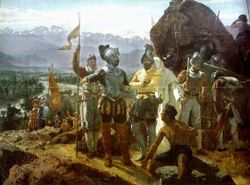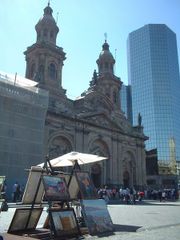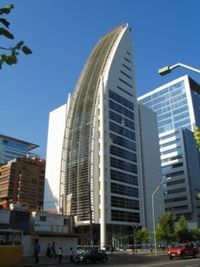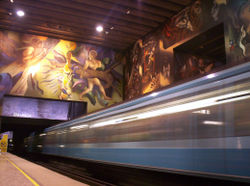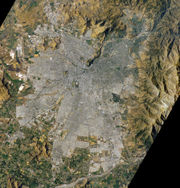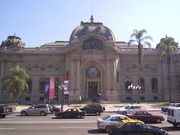Santiago, Chile
2007 Schools Wikipedia Selection. Related subjects: Central & South American Geography
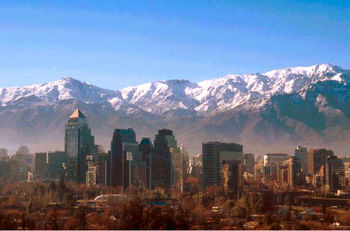
Santiago (Spanish: Santiago de Chile ) is Chile's capital and largest city. It is situated at an elevation of 520 m (1700 ft) in the country's central valley, and administratively is a part of the Santiago Metropolitan Region. Even though Santiago is the capital, legislative bodies meet in nearby Valparaíso.
Approximately two decades of uninterrupted economic growth have transformed Santiago into one of Latin America's most sophisticated metropolitan areas, with extensive suburban development, dozens of shopping malls, and impressive high-rise architecture. The city also boasts some of Latin America's most spectacular infrastructure, such as the Santiago Metro and the sparkling new "Costanera Norte," a freeway system that passes below downtown and connects the Eastern and Western extremes of the city in 15 minutes. Santiago is headquarters to many important companies and is a regionally important financial centre.
Basic urban data (2002)
Population (Greater Santiago): 5,456,326
Area: 64,140 ha
Density: 85.1 hab/ha
Climate
Santiago has a mild Mediterranean climate: relatively hot dry summers (November to March) with temperatures reaching up to 35 degrees Celsius (95 degrees Fahrenheit) on the hottest days; winters (June to August) are more humid, with typical maximum daily temperatures of 15 degrees Celsius (59 degrees Fahrenheit), and minimums of a few degrees above freezing. Ocasional snowfall occur on higher suburbs of the city. Mean rainfall is 338 mm per year.
| Jan | Feb | Mar | Apr | May | Jun | Jul | Aug | Sep | Oct | Nov | Dec | |||
|---|---|---|---|---|---|---|---|---|---|---|---|---|---|---|
| Mean daily maximum temperature ( °C) | 29 | 29 | 27 | 22 | 18 | 14 | 14 | 16 | 18 | 22 | 25 | 28 | ||
| Mean daily minimum temperature ( °C) | 12 | 12 | 9 | 7 | 5 | 3 | 3 | 4 | 6 | 7 | 9 | 11 | ||
| Mean total rainfall ( mm) | 0 | 3 | 5 | 13 | 58 | 79 | 76 | 53 | 28 | 13 | 5 | 5 | ||
| Source: Weather.co.uk Climate Statistics | ||||||||||||||
Thermal inversion (a meteorological phenomenon whereby a stable layer of warm air holds down colder air close to the ground) causes high levels of smog and air pollution to be trapped and concentrate within the Central Valley during winter months. In the 1990s air pollution fell by about one-third, but there has been little progress since 2000.
The Mapocho river, which crosses the city from the north-east to the south-west of the Central Valley, is contaminated by industrial and household sewage, dumped unfiltered into the river, and by upstream copper-mining waste (there are a number of copper mines in the Andes east of Santiago). The central government recently passed a law that forces industry and local governments to process all their wastewater by 2006. There are now a number of large wastewater processing and recycling plants under construction. There are ongoing plans to decontaminate the river and make it navigable.
Sound levels on the main streets are high, mostly because of noisy diesel buses. Diesel trucks and buses are also major contributors to winter smog. A lengthy replacement process of the bus system began in 2005 and will last until 2010 (see Transportation section below).
History
Santiago was founded by Pedro de Valdivia on February 12, 1541 with the name Santiago de Nueva Extremadura. The founding ceremony was held on Huelén Hill (later renamed Cerro Santa Lucía). Valdivia chose the location of Santiago because of its moderate climate and the ease with which it could be defended—the Mapocho River splits into two branches and rejoins further downstream, forming an island.
The first buildings were erected with the help of the native Picunche Indians. The south bank of the Mapocho River was later drained and converted into a public promenade, known as the Alameda (now Avenida Alameda Libertador Bernardo O'Higgins). The city was slightly damaged during the War of Independence ( 1810– 18), in the Battle of Maipú, which was fought south-west of the city. Santiago was named capital in 1818.
During the early 19th century, Santiago remained a small town with few buildings excepting Palacio de La Moneda, the building used as the Chilean mint during the Spanish period, and a few churches and other civic buildings. The Iglesia de la Compañía de Jesús caught fire during an 1863 church service, and 2000 people died, one of the worst modern fires .
In the 1880s extraction of nitrate fertilizer in Northern Chile brought prosperity to the country, and promoted the capital city's development. Important landmarks were built in 1910 during the Centennial celebrations of independence from Spain, such as the National Library and the Museum of Fine Arts.
Santiago began its transformation into a modern city in the 1930s, with the building of the Barrio Cívico, surrounding El Palacio de La Moneda. The city also grew in population, due to migration from the north and south of Chile. In 1985 an earthquake destroyed some historically significant buildings in the downtown area.
Santiago is now often considered the most important financial centre in Latin America.
People
The population of Santiago's urban agglomeration grew from 0.982 million in 1940 to 2.82 million in 1970 and 4.75 million in 1992. According to the 2002 census, it contains a population of about 5.45 million, equivalent to nearly 37% of the total population of the country and 43% of the total urban population, making it one of the largest cities in Latin America.
Much of Santiago's population descend from white Europeans , initially Spaniards, but later included government sponsored immigrants of German, Swiss, and English origins. They were later followed by Italians, Irish, and Croats immigrants. Inhabitants of mixed European and Amerindian (mestizo) make up a significant portion of the population.
The city is increasingly receiving immigration from other countries in Latin America due to comparatively strong economic growth. Many Peruvians live in Santiago, as well as Bolivians, Argentines, and Ecuadorians.
Economy
Santiago is the most important industrial and financial centre of Chile. It generates 45 percent of the country's GDP. Also, the city is, along with Buenos Aires and São Paulo, one of the biggest financial centers of South America. Some international institutions, such as ECLAC (Economic Commission for Latin America and the Caribbean), have their offices in Santiago. In recent years, due to the strong growth and stability of the Chilean economy, many multinational companies have chosen Santiago as the place for their headquarters in the region, like HP, Reuters, JP Morgan, Intel, Coca-Cola, Unilever, Nestlé, Kodak, BHP Billiton, IBM, Motorola, Microsoft, Ford, Yahoo!, and many more.
Transportation
Santiago's national and international airport is Arturo Merino Benítez International Airport and ranks high regionally in terms of quality. Trains operated by Chile's national railway, Empresa de los Ferrocarriles del Estado, connect Santiago to Puerto Montt, in the central-southern part of the country, and to the North they connect the capital with the city of Iquique. All such trains arrive and depart from the Estación Central ("Central Station"). Private inter-urban bus companies provide excellent and cheap transportation from Santiago to virtually any part of the country. There are also several new inter-urban toll highways connecting the city's extremes including the Vespucio Highway (which surrounds the city describing a semi-circle), The Ruta 5 (which crosses the city in North-South direction) and the Costanera Norte (which runs from the eastern side in Las Condes to the western in Pudahuel).
Santiago's urban passenger transportation system include an extensive, if chaotic, privately run bus service as well as a publicly owned subway. The buses are known as micros (for microbus) and are typically colored yellow. This bus system is in the process of being completely replaced by early 2007 by a new system which includes new routes and larger, newer buses, with a better payment system ( Multivia card), compatible with the subway (see Transantiago). The subway is clean and safe and has five operating lines but their coverage is still somewhat limited towards the southern and northern edges of the city. The Government just inaugurated two additional subway lines (Line 4 and 4a), but it is still being expanded, and is building extensions to Lines 1 and 2 (see Santiago Metro).
Taxicabs can usually be found on the streets and are painted black with yellow roofs; unmarked taxis may be called up by telephone (Radiotaxis). Colectivos are shared taxicabs that carry passengers along a specific route, for a fixed fee.
Construction
Currently under construction is the Costanera Centre, a mega project in Santiago's Financial District. This includes a 280 000 square meter mall, a 300 meter tower, two office towers of 170 meters each, and a hotel 105 meters tall. When completed in 2010 it will be the tallest building in South America. Near Costanera Centre another skyscraper is being built, Titanium La Portada, and this will be 190 meters tall. Although these are the two biggest projects, there are many other office buildings under construction in Santiago, as well as hundreds of high rise residential buildings.
Political divisions
Greater Santiago extends throughout 37 municipalities and covered 64.140 ha in 2002. The majority of Santiago lies within the same named province, with some peripheral areas contained in the provinces of Talagante, Maipo and Cordillera. Specifically, Santiago joins the cities of San Bernardo (Maipo province) and Puente Alto (Cordillera province) to form the Greater Santiago conurbation.
The province of Santiago is divided into 32 municipalities (comunas in Spanish). Each municipality in Chile is headed by a mayor (alcalde) elected by voters every four years. The members of the municipal council (concejales) are elected in the same election on a separate ballot.
The 32 municipalities are: Cerrillos, Conchalí, Cerro Navia, El Bosque, Estación Central, Huechuraba, Independencia, La Cisterna, La Florida, La Granja, La Pintana, La Reina, Las Condes, Lo Barnechea, Lo Espejo, Lo Prado, Macul, Maipú, Ñuñoa, Pedro Aguirre Cerda, Peñalolén, Pudahuel, Providencia, Quilicura, Quinta Normal, Renca, Recoleta, San Joaquín, San Miguel, San Ramón, Santiago Centro, and Vitacura.
Cultural life
Music
There are two symphonic orchestras:
- Orquesta Filarmónica de Santiago, which performs in the Teatro Municipal
- Orquesta Sinfónica de Chile, dependent of the Universidad de Chile, performs in its theatre.
There are also various jazz establishments, the most notable being the Club de Jazz in Ñuñoa.
Museums
Museums include:
- Centro Cultural Palacio de La Moneda, newest and biggest cultural space, beneath the Citizenry Square, in the south front of the government palace La Moneda
- Museo Arqueológico de Santiago
- Museo de Santiago Casa Colorada
- Museo Catedral Metropolitana
- Museo Colonial San Francisco
- Museo Chileno de Arte Precolombino
- Museo Histórico Nacional
- Museo Nacional de Bellas Artes
- Museo de Arte Contemporáneo
- Museo Interactivo Mirador
- Museo Artequín
- Museo de Ciencia y Tecnología
- Museo Ferroviario
- Museo de la Solidaridad "Salvador Allende"
- Palacio Cousiño
- La Chascona, Pablo Neruda's house, now a museum
Recreation
The city's main parks are:
- San Cristóbal Hill (Cerro San Cristóbal), which includes the Santiago Metropolitan Park Zoo
- O'Higgins Park (Parque O'Higgins)
- Forestal Park (Parque Forestal), park located at the city centre alongside Mapocho river
- Cerro Santa Lucía
Modern ski resorts within an hour's drive east from the city include:
- Farellones
- Valle Nevado
- La Parva
- Portillo is about three hours away.
Some of the country's most important winegrowing areas lie in the nearby Maipo and Aconcagua Valleys. Several vineyards are located in this area:
- Concha y Toro
- Santa Rita
- Santa Carolina
- Cousiño Macul
Cultural places to visit include:
- Museo de Bellas Artes
- Barrio Bellavista, cultural and bohemian neighbourhood
- Central Station, railway station designed by Gustave Eiffel
- Víctor Jara Stadium
- Ex National Congress
- Plaza de Armas, downtown square
- Palacio de La Moneda, government palace
Main soccer stadiums:
- National Stadium (site of the 1962 World Cup final)
- Estadio David Arellano (Monumental)
- Estadio San Carlos de Apoquindo
Religion
Most of Chile's population is Catholic and Santiago is no exception. According to the National Census, carried out in 2002 by the National Statistics Bureau ( INE), in the Santiago Metropolitan Region, 3,129,249 people 15 and older identified themselves as Catholics, equivalent to 68.7% of the total population, while 595,173 (13.1 %) described themselves as evangelical protestants. Around 1.2% of the population declared to be Jehovah's witnesses, while 0.9% identified themselves as Latter-day Saints (Mormons), 0.25 as Jewish, 0,03 as Moslems and 0,11 as Orthodoxs. Approximately 10.4% of the population of the Metropolitan Region stated that they were atheist or agnostic, while 5.4% declared to follow other religions.
Source : INE, Chile, 2002 Census
Universities
- Pontificia Universidad Católica de Chile (Pontificial) spanish english
- Pontificia Universidad Católica de Valparaíso (Pontificial) spanish english
- Universidad de Chile (Of Chilean State) spanish
- Universidad Técnica Federico Santa María (Of Chilean State) spanish english
- Universidad de Valparaíso (Of Chilean State) spanish
- Universidad de Santiago (Of Chilean State) spanish
- Universidad Tecnológica Metropolitana (Of Chilean State) spanish
- Universidad Metropolitana de Ciencias de la Educación (Of Chilean State) spanish
- Universidad de los Andes (Private) spanish
- Universidad Adolfo Ibañez (Private) spanish
- Universidad Finis Terrae (Private) spanish
- Universidad Andrés Bello (Private) spanish english
- Universidad del Desarrollo (Private) spanish
- Universidad Mayor (Private) spanish
- Universidad Diego Portales (Private) spanish

